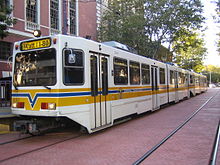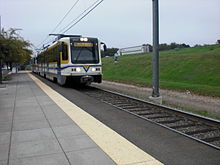Transportation in the Sacramento metropolitan area
[2] A further 7.03% of workers in the region work from home, so the transportation modes of the remaining roughly 6.5% are rounded out by public transit, cycling, walking, motorcycle riding, and other means.
To the south, I-5 provides service to Stockton, Los Angeles, and San Diego, terminating at the Mexico–United States border.
The highway enters Sacramento County from the south near Thornton, then continues northward through the western edge of Elk Grove that is mostly uninhabited wetlands with the exception of Laguna West.
The river then makes an abrupt westward curve after which the highway is flanked by the south Sacramento neighborhoods of Pocket-Greenhaven on the west and Meadowview on the east.
As it reaches the southwest corner of the downtown grid, the highway has a full-service junction with the 50/Business 80 freeway, and also merges with California State Route 99 for a concurrency.
Roughly three miles north, I-5 abruptly curves westward as California State Route 99 splits off and continues northward towards Yuba City and Marysville, ending the concurrency.
I-5 reaches Woodland, curves to the northwest direction, and then has a partial-service interchange with California State Route 113 at its northern terminus.
After passing through Woodland, the highway converges with Interstate 505 near Dunnigan, then exits Yolo County, heading towards Redding and the Pacific Northwest.
It continues to eastern Sacramento suburbs including La Riviera, Rosemont, Rancho Cordova, and Folsom.
It makes its way through many small municipalities, including Placerville and Pollock Pines and then reaches South Lake Tahoe.
To the south, it serves the Central Valley cities of Stockton, Modesto, Fresno, and Bakersfield before terminating at the Wheeler Ridge Interchange to join I-5.
It then routes along the west side of the rural farming communities Herald and Wilton before going through the core of Sacramento's suburban city on the south, Elk Grove.
The college and medical complex are both immediately to the west of SR 99; there are exits to Bruceville Road designed to give emergency vehicles easy and quick access to the hospitals.
At the junction with US 50 in the southeastern part of the central city, the thru lanes turn into the eastern section of Business 80.
SR 99 does not continue straight, and instead connects to US 50 in the stretch west of the junction also known as the WX Freeway, in an unsigned concurrency (along with Business 80).
SR 99 splits off from I-5 in North Natomas, with a slight northward jog, while I-5 makes a much sharper curve westward towards Sacramento International Airport and Woodland.
Around this point, the freeway also converges with California State Route 160 (SR 160), a highway that provides direct travel to Downtown Sacramento from the Arden-Arcade area.
The freeway portion routes all the way to Woodland, where it briefly overlaps with I-5, then exiting and heading towards Knights Landing as a two-lane highway again.
It then passes Sheridan and Wheatland before terminating in Olivehurst, where it converges with California State Route 70 to continue on to Marysville.
As it approaches Woodland, SR 16 turns 90 degrees to a northward direction at an intersection on the western edge of town.
SR 16 is carried on the Howe Avenue section that is south of US 50 for a very short distance before turning eastward onto Folsom Boulevard.
Less than a mile later, the route branches off from Folsom Boulevard on the south side as Jackson Road, and it is also the beginning of the signed portion east of the concurrency.
At this point, the southern portion of SR 160 ends and the route is now referred to as Freeport Boulevard, as it widens to a four-lane expressway.
It passes through the Meadowview neighborhood and then forms the western boundary of the Sacramento Executive Airport as it goes through South Land Park.
The primary transit agency in the Sacramento metropolitan area for inter-city rail service is Amtrak.
Through SMF, passengers can fly directly to many major cities across the contiguous United States as well as Mexico, Vancouver, and Hawaii.
The Sacramento Deep Water Ship Channel was a manmade canal created to exchange goods with the Port of Oakland.
In Sacramento, cycling is a common means of transportation, especially in the central city (Downtown and Midtown), where residents and visitors find it to be safe, cheap, and efficient.
Many of the city streets in the urban core have 3 ft. wide designated bike lanes, some are painted bright green, and some are placed between the sidewalk and the parked cars (providing a physical barrier from moving motor vehicle traffic).
This is more than the double the city with the next-highest percentage of bicycle commuters (Berkeley, California, another college town, with 9.7%).










